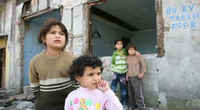Istanbul. Video: Canım Sulukule../My Beloved Sulukule..
This photo-reportage witnesses the last 2 and a half years of Sulukule, a gypsy neighborhood in Istanbul now completely demolished as part of an urban transformation project carried out by the Fatih municipality, during the years 2005-2010. The people of Sulukule themselves wanted to have their pictures taken and they posed for the camera desiring to have one last memento of their homeland.
In the background is the voice of Gulsum Abla, whose house in Sulukule was under the threat of demolition at the time, but now also demolished. She tells us her feelings about being a gypsy, living in poverty and discrimination. She talks about the old happy days of her childhood in her beloved Sulukule. Her song at the end sums it up: ‘I’m All Alone’.
Nejla Osseiran
- My Beloved Sulukule..
The first time I visited Sulukule was the summer of 2007. A friend who was working for the European Roma Rights Centre (ERRC) in Budapest had asked me to go there and take a few pictures for an article to be published on their web newsletter.
I knew I would go there again and again. At the beginning some people approached me with caution. ‘They come and take our pictures and we never see them again!’ they said. I promised I would bring their pictures the next time. And I did. Gradually, I had fewer reluctant residents. Some wanted the pictures as a ‘keepsake’, some wanted to send them to their husbands or sons in the army or prison. Most of the people knew they were going to be evicted and they wanted some kind of souvenir or memento.
In each of the following times that I went to Sulukule, there were fewer houses, fewer families and children. Among the ruins the dark shadow of joylessness was spreading time and again. Some families were hopeful about the place they were going to move to. Some, especially the children, hated the idea. Sometimes I was not able to give the pictures because I could not find the people or their houses there. They would be gone. During this period I learned so much from them and about them. I realized that in time I had become their ‘Nejla Abla’. They would be so happy to see me when I went. They invited me in their houses and posed for me. I would be giving them either their pictures or pictures of people they knew and loved. Each time I went, my heart felt heavier. It was steadily taking the shape of a disaster area. Most of the houses were in rubble or completely gone. Each time I went, I felt more hopeless and helpless... Still I went - I felt I could not let them down. I knew they would be waiting for their pictures and the light I saw in their eyes overshadowed the shame of humanity, the brutality of poverty. I tried to keep my distance but after you get to know those people it is very difficult to forget them.
I never did.
Cihan Uzunçarşılı Baysal - An aphorism on conscience: The documentary entitled "My beloved Sulukule.."
"The problem is not that people remember through photographs but that they remember only the photographs," writes Sontag, "This remembering through photographs eclipses other forms of understanding—and remembering’’[1] “To remember is, more and more, not to recall a story but to be able to call up a picture,[…] but when it comes to remembering, the photograph has the deeper bite."[2] We are in need of this authentic power of photography to be able to remember Sulukule in the future as a district that has been entirely demolished today, to be able to construct Sulukule in our recollection with its unique voice, color, culture, people and language and to be able to internalize the pain it has suffered.
The neighborhood has been torn down, its residents banished, its voice and music silenced. Moreover, a brutal 'cleaning' operation is underway today to wipe out any traces of the past, such that those who will attempt to search the location of Sulukule in the future will have second thoughts about its existence. Yet, as Najla's footage play frame by frame, the Sulukule that they try to efface from the memory of the city will once more come to life and once more challenge its own destruction with every viewer. With every finger pressing to click on the link to dear Najla's "My Beloved Sulukule.." and the unconscious contextualization of the selected and internalized frames, Sulukule will become a familiar district even to those who have not known about it and will strengthen its place in the collective memory.
The viewer is encountered not only with a recollection area but also a confrontation area. Empathizing with victims and victimhood by confronting the conscience aims to situate violence and oppression in the collective memory and thus to prevent recurrence; those who cause oppression are doomed forever. Going back to Sontag, we read: "In an era of information overload, the photograph provides a quick way of apprehending something and a compact form for memorizing it. The photograph is like a quotation, or a maxim or proverb."[3] "My Beloved Sulukule.." is, at the same time, a proverb that rises upon human values, confronting us with our conscience.
Throughout the documentary, doors open one by one and welcome us inside; so our roads cross with 'the other', and going beyond mere crossing, we now enter their lives, perch on the edge of their privacy, like shy guests. As the pain of the others resonate one by one, Gülsüm, the voice and conscience of the neighborhood starts to speak. Gülsüm speaks, talks piece by piece, without giving a break, without stopping to breath... as if they and the dozers would soon raid the neighborhood and the dialog would have to be terminated, yet there is so much to tell, she has to tell us about everything before they and the dozers arrive, all the regret harbored in her heart, the suffering, the torment taking place in front of the entire city, yet not seen / ignored by the majority, all the wrong and the injustice have to be unmasked, she has to speak before they come, before the dozers raid in, one never knows when they will come because they arrive any time be it at dawn or at night, they have no mercy for the sick/the old/the children/the pregnant, they and their dozers, that is why they have notes on their windows reading 'Attention Dozer: There are people in this house!', this is why they all hang their clothes on the doors and windows, Gülsüm talks and talks without pause, talks as if racing with the dozers: Houses marked with red crosses, houses 'cautioning' the dozers, walls with writings 'welcome to Gaza' or 'welcome to the dead city', children and rubble and rubble and children, and of course the women and the elderly and the old man crouched in front of the writing on the wall, written with the optimism of the Sulukule people: ‘A day will come and this will end...', the expression on his face sweeping away all optimism and Gülsüm speaks, staring afar with a bitter gaze, she speaks; we feel through sight and comprehend as we see. When Gülsüm stops, the viewer is no more the person he/she was at the beginning, is bitten deeper and seized by an urge to revolt; no doubt that another witness has been added to the list of those who will testify in.
//While we record, one by one, in our memories, what they, the oppressors do not see and do not understand; we may be faced someday, somewhere, perhaps at unexpected moments and even at moments within broader spans, with the pain given to the others may and our conscience may be disturbed. A child's face in Tarlabaşı, a woman's laugh in Fener-Balat, a wall in Ayvansaray or an old man from this neighborhood... Gülsüm is silent this time among the images from “My Beloved Sulukule” that slip from the memory’s trunk that is opened with a sense of déja vu , and conscience speaks; it speaks that being merely a spectator to the agony of others means indirect participation in the crimes committed. Sontag continues: "The photographs are a means of making 'real' (or 'more real') matters that the privileged and the merely safe might prefer to ignore." And "My Beloved Sulukule.." also serves such a function; while forcing those living in their comfort zones to look at the pain of 'the others', it stirs the conscience and points to the need to fight injustice...and reiterates and reminds us that we are human.
[1] Susan Sontag, ‘Looking at War: Photography's View of Devastation and Death’, The New Yorker , Dec.9th .2002.
[2] Susan Sontag, Regarding the Pain of Others,2003.
[3] ibid.
Translation by : Mine Sengel

